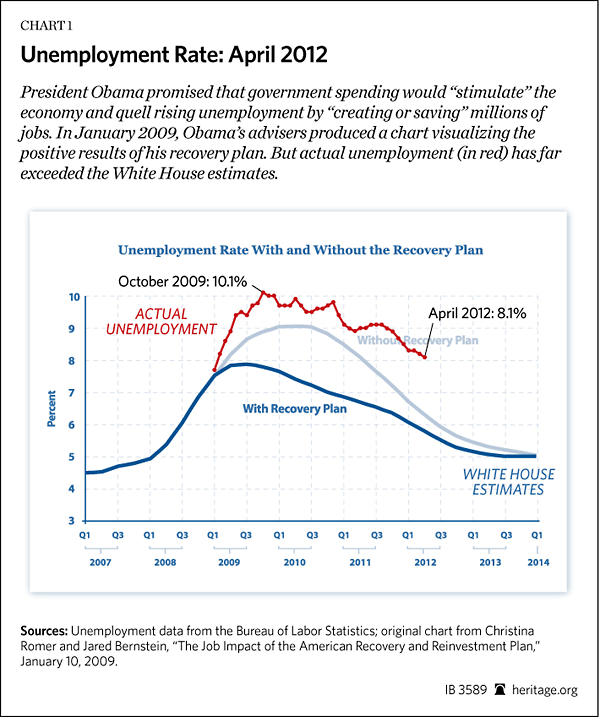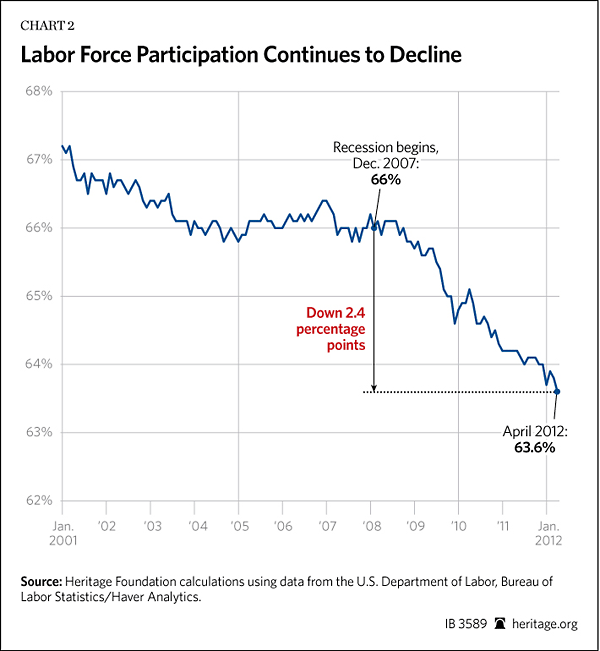The Bureau of Labor Statistics reported that the economy added 115,000 jobs in April and the unemployment rate declined to 8.1 percent from 8.2 percent. However, further declines in the percentage of Americans in the labor force explain this slightly lower unemployment rate. Indeed, the labor force participation rate dipped to a 30-year low as many unemployed workers simply left the labor force.
The April report is further evidence that the job market has cooled from its more rapid growth in the first quarter. This slowdown will likely spur calls for more stimulus spending. However, government spending comes at the expense of private-sector growth. Congress should instead focus on improving the business climate.
The April Report
The slight decline in the unemployment rate was the result of 342,000 individuals leaving the labor force. The labor force participation rate declined from 63.8 percent to 63.6 percent, the lowest level since December 1981. This is a troubling sign. Economists expected the rate to rebound at this stage of the recovery.

Adult men accounted for all of the decline as their participation rate fell from 73.3 percent to 72.9 percent, a new all-time low. The participation rate of adult women was unchanged at 59.3 percent. As a result, the unemployment rate of adult men declined from 7.6 percent to 7.5 percent, while the unemployment rate for adult women was constant at 7.5 percent. The alternative measures of unemployment were mostly unchanged from March.

There was some slight good news, as the duration of unemployment declined from 39.4 weeks to 39.1 weeks. The median duration also declined to 19.4 weeks—the first time since 2009 that the median duration of unemployment has remained below 20 weeks for consecutive months.
The payroll survey reported 130,000 new private-sector jobs and 115,000 total new jobs, which was below expectations. This was the lowest private-sector job growth since August 2011. Revisions to previous months raised the number of employed workers by 19,000 in February and 34,000 in March.
Job growth was concentrated in the service sector (116,000) and manufacturing (16,000), but government (–15,000) and construction (–2,000) saw job declines. Professional and business services (62,000) had strong job growth, while temporary services (21,100) rebounded from a 10,000 job decline in March. Professional and technical services (27,500) are high-skill jobs and accounted for almost half of the job growth in the professional and business sector. Health care (19,000) continued to grow, as did leisure and hospitality (12,000). Local government, education (–10,700), and federal government (–4,800) accounted for the decline in government jobs.
Average weekly hours remained flat for all employees and for just production and non-supervisory employees. Average hourly earnings increased from $19.69 to $19.73 for the latter. Overtime work for durable manufacturing increased by 0.1 hours. These measures are another indication that the labor market is not tightening or improving nearly as much as it did in the first quarter.
Calls for New Stimulus
Two consecutive disappointing employment reports are likely to renew calls by some in Washington and by labor unions for more stimulus spending. Keynesian theory claims that, in a weak economy, deficit-financed spending also boosts the private sector through a “multiplier” effect. This theory holds that additional government spending employs previously idle workers, enabling them to maintain their level of consumption, which in turn employs more idle workers, and so on.
Keynesian theories do not work in practice. Another round of stimulus would not boost the economy any more than the original stimulus did. Instead, it would only increase the level of public-sector debt, which does, in fact, slow the economy.
Misdirecting Resources According to Political Criteria
The stimulus failed because government spending takes resources from the private sector and redirects them according to political criteria. These political criteria usually have little relation to economic value. Further, government spending often transfers private-sector workers with jobs to different—but federally funded—jobs. This does not boost the private sector.
Consider federal infrastructure projects. Employers on federally funded construction projects must pay union wages and use union work rules. Unsurprisingly, unions strongly lobbied for the 2009 stimulus, which greatly increased federal construction spending. However, there was no connection between stimulus spending and local unemployment rates. The government did not spend more in areas with more unemployed workers available. Districts represented by Democrats and committee chairmen, however, got significantly more funding.[1]
This was a predictable result. The skills necessary to build a bridge are very different from the skills necessary to build a house. Increased infrastructure spending raised demand for unionized crane operators and ironworkers—many of whom already had jobs. It did much less for unemployed residential carpenters. Surveys show that more workers on stimulus projects came directly from other employers than from the ranks of the unemployed. Similarly, companies that found hiring qualified workers easy did not get more funding.[2] Politically directed spending seldom uses economic resources efficiently.
Depresses Private Economic Activity
Transferring workers from private to federal projects does not boost the private sector. Research shows that a $1 increase in government spending reduces private-sector economic activity by $0.50.[3] The classic Keynesian multiplier effect does not occur in reality. Government spending only boosts the size of government—at the cost of private-sector activity. Congress should not expect another round of stimulus would induce entrepreneurs to hire.
A better solution would be to focus on policies that encourage business expansion. Nearly twice as many (39 percent) small business owners say that taxes or government regulations are their greatest problem than cite poor sales (22 percent).[4] Instead of spending more, Congress should reduce barriers to private-sector wealth and job creation.
A Discouraging Picture
The April employment report indicates a stalling labor market. The payroll survey reported employers created only 115,000 net jobs—enough to keep pace with population growth but not enough to reduce unemployment. Unemployment dropped only because many potential workers stopped looking for jobs. One report is not enough to demonstrate the recovery has flatlined, but it paints a discouraging picture of the economy and its near-term trend.
This report is likely to renew calls for more stimulus spending. This would do nothing to boost the private sector; it would only stimulate the size of the government. Congress should instead focus on removing barriers to job creation and business success. Indeed, a clear path to greater economic activity is laid out in Saving the American Dream, Heritage’s plan for solving the federal fiscal crisis and boosting economic growth.[5]
Rea S. Hederman, Jr., is Assistant Director and Research Fellow, and James Sherk is Senior Policy Analyst in Labor Economics, in the Center for Data Analysis at The Heritage Foundation.


